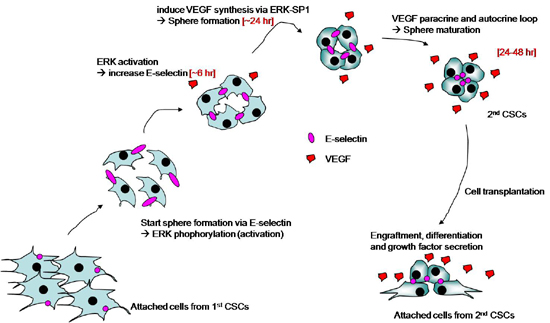| єя«•«ьљƒ : ±Єњђ
|
ЅҐЉцєш»£ - 540029 87 |
Secondary sphere formation enhances the functionality of cardiac progenitor cells
from murine and human cardiac explants |
| мДЬмЪЄлМАнХЩкµР мЭШк≥ЉлМАнХЩ¬є ,мДЬмЪЄлМАнХЩкµРл≥СмЫР мЛђнШИкіАмДЉнД∞¬≤ ,кµ≠к∞АмІАм†Х мЛђнШИкіАм§ДкЄ∞мДЄнПђ мЧ∞кµђмЛ§¬≥ ,нШБмЛ†нШХ мДЄнПђмєШл£М мВђмЧЕлЛ®вБі |
мЭінШЄмЮђ¬є¬≥, м°∞нШДмЮђ¬≤¬≥вБі,мЬ§мДЭмЫР¬є¬≥ ,к≥†мДЭмІД¬є¬≥ ,мЫРм£ЉмЬ§¬є¬≥ ,м†ХмЧ∞м£Љ¬є¬≥ ,мЬ§м∞љнЩШ¬≤¬≥ ,мЭімДЄмЫР¬≥вБі,мЭімЭАм£Љ¬≥вБі,мЭінХімШБ¬≤¬≥ ,мЭімГБнЧМ¬є ,нШЄмЫРк≤љ¬є ,
л∞ХмШБл∞∞¬є¬≤¬≥вБі,кєАнЪ®мИШ¬є¬≤¬≥ |
Objective: We investigated a new strategy that enhances cellular potency and provides an enriched source of cardiac progenitor cells.
Background: Recent studies suggest that resident cardiac stem/progenitor cells could be an optimal cell source for repairing a damaged heart. However, cardiac progenitor cells are difficult to maintain in terms of purity and multipotency when propagated in attached 2-dimensional culture systems in vitro.
Methods: We applied the repeated sphere formation strategy (that is, cardiac explant migrating cells out of explant primary cardiosphere (CS) formation cardiosphere-derived cells (CDCs) in adherent culture condition secondary CS formation by 3-dimensional culture)
Results: Murine CSs were generated from cardiac explants of C57BL/6 mice. Cells in secondary CS showed a higher potency and differentiation potentials. Furthermore, when transplanted into the infarcted myocardium, secondary CSs engrafted robustly, improved LV dysfunction, and reduced infarct sizes more than CDCs did. In addition to the cardiovascular differentiation of transplanted secondary CSs, paracrine effects, such as, robust VEGF secretion, were found to enhance neovascularization in the infarcted myocardium. Regarding the molecular mechanisms involved, ERK/E-selectin and ERK/Sp1/VEGF auto-paracrine loop were responsible for sphere initiation and maturation, respectively. When we applied this strategy to adult human cardiac tissues, secondary CS was readily generated, and cellular characteristics and molecular pathways of sphere formation were similar to murine findings.
Conclusion: These results provide a simple and reproducible strategy for enhancing cellular potency for cardiac repair. Furthermore, this strategy may be applicable to other types of stem/progenitor cells for cell-based therapy.
|
|
|
Warning: getimagesize(/home/virtual/circulationadmin/renewal/econgress/conference/abstract/img_files/snu2cs.jpg) [function.getimagesize]: failed to open stream: No such file or directory in /home/virtual/circulationadmin/new/econgress/conference/manage/schedule/view_abstract.php on line 164

|
|





